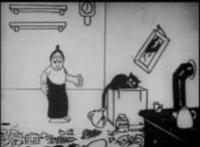
Feline Follies is an important early animated short film produced by the Pat Sullivan Studio and directed by Otto Messmer. Released in 1919, it is historically significant as the first appearance of Felix the Cat, one of the most iconic and influential characters in the history of animation. This film marked the beginning of Felix’s long-lasting legacy, establishing him as one of the first animated stars and a key figure in the development of the animation industry.
The Making of Feline Follies
Feline Follies was created during the silent film era, a period when animation was still in its infancy. The film was produced by the Pat Sullivan Studio, which was founded by Australian-born Pat Sullivan. Although Sullivan is often credited as the creator of Felix the Cat, much of the actual design and animation work was carried out by Otto Messmer, an animator who played a significant role in bringing Felix to life. Messmer’s fluid animation style and creative input helped shape Felix’s distinct personality.
At the time of Feline Follies' creation, Sullivan and Messmer were working in a competitive field of early animation, with other characters such as Krazy Kat and Gertie the Dinosaur emerging around the same period. The production of Felix’s debut film demonstrated the rapid evolution of animation, particularly in the way characters were able to express emotions and interact with their environments.
Plot of Feline Follies
The plot of Feline Follies revolves around Felix, a mischievous black cat who embarks on a series of comedic misadventures. As was common in many early animated shorts, the story is relatively simple and consists of a series of visual gags and physical comedy.
In Feline Follies, Felix finds himself in a chaotic situation as he tries to woo a female cat. The film showcases Felix’s personality, which was characterized by his cheeky antics, charm, and resourcefulness. Throughout the short, Felix uses his wits and cunning to navigate a series of humorous and sometimes absurd scenarios, with each gag relying on the basic principles of slapstick comedy.

The absence of dialogue, common in silent films, is compensated by exaggerated facial expressions and physical movements, allowing Felix to communicate his emotions and reactions. This allowed the character to transcend language barriers, making the film appealing to audiences across the world.
Animation and Style
Feline Follies is notable for its fluid animation and use of expressive character movements, which were groundbreaking at the time. Felix, though a simple character in design, is full of life and charm, thanks to Messmer's skillful animation. The smoothness of Felix’s movements and his ability to interact with his environment helped set him apart from other animated characters of the era.
The animation style of Feline Follies is typical of the silent era, with a heavy reliance on visual gags, exaggerated movements, and physical comedy. The use of exaggerated motions and facial expressions, even without sound, made Felix’s actions immediately understandable and humorous to audiences. The short also employs simple yet effective background designs, which highlight the focus on the characters and their antics.
The black-and-white film also reflects the aesthetic of the period, though the character of Felix, with his large white eyes and black body, stands out starkly against the minimal backgrounds, making him visually striking.
Felix the Cat’s Impact
The release of Feline Follies was a landmark moment in the history of animation. Not only did it introduce the world to Felix the Cat, but it also demonstrated the potential of animation as a medium for storytelling and comedy. Felix’s mischievous character and charming design made him a favorite with audiences, and he quickly became one of the most popular animated characters of the 1920s.
In 1923, Felix made his first appearance in a comic strip, which further boosted his popularity. His success helped establish animated characters as stars in their own right and laid the groundwork for the growth of animation as a commercial art form. Felix's influence was so profound that he became a precursor to other famous characters in animation, such as Mickey Mouse.
Feline Follies was one of the first animated films to feature a recurring character in a meaningful way, and its success helped solidify the idea of animated characters becoming beloved figures that could carry multiple stories and films.
Legacy of Feline Follies and Felix the Cat
Though Feline Follies was not as technically advanced as later animated films, it played a pivotal role in the evolution of the animation industry. Felix the Cat became the first major animated star, and his popularity would continue throughout the 1920s. Over time, Felix appeared in over 150 films, becoming the highest-grossing animated character of the era.
The character of Felix, who would go on to feature in comic strips, merchandise, and a long-running series of cartoons, remains a significant part of animation history. Even after the rise of other iconic animated characters like Mickey Mouse, Felix the Cat maintained a legacy as one of the trailblazers of early animation.
Feline Follies continues to be celebrated as the film that introduced the world to one of animation’s most enduring figures. Felix’s playful spirit, coupled with the innovative animation techniques of the time, made Feline Follies a classic and an important milestone in the history of animated films.
Feline Follies is a historic animated short that marks the debut of Felix the Cat, one of the first true animated stars. Its release in 1919 helped set the stage for the growth of animation as a commercial and artistic medium. The film’s clever visual humor, innovative animation, and endearing protagonist made it a hit with audiences and solidified Felix’s place in animation history. Today, Felix remains an iconic figure, and Feline Follies is remembered as a key moment in the evolution of animated storytelling.